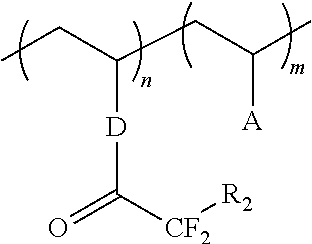Superacid functional compounds
a superacid and functional technology, applied in the field of superacid functional molecules, can solve the problems of reducing the desirable proton conductivity performance, reducing the availability of starting materials, and reducing the efficiency of the overall system
- Summary
- Abstract
- Description
- Claims
- Application Information
AI Technical Summary
Benefits of technology
Problems solved by technology
Method used
Image
Examples
example 1
Small Molecule Syntheses
1,1-difluoro-2-oxo-2-phenylethanesulfonate (DEOPESA)
[0069]
Structure of 1,1-difluoro-2-oxo-2-phenylethane sulfonate. Z+=hydrogen, metal or organic counterion.
[0070]A 2-necked, 250 mL round-bottomed flask was equipped with a magnetic stir bar and 0.602 g magnesium turnings. It was purged with dry nitrogen and stirred for 18 hours. Separately, 2.63 mL of p-bromobenzene was dissolved in 20 mL of anhydrous THF in a 60 mL addition funnel. This funnel was attached to the 250 mL round-bottomed flask and 1.5 mL of the p-bromobenzene solution was added to the flask along with 50.0 μL of 1,2-dibromoethane and stirred at room temperature for 10 minutes. The remainder of the p-bromobenzene solution was then added over 1 hour and the temperature of the reaction mixture was observed to increase to reflux. External heat was applied and the mixture was refluxed for an additional 1 hour producing a clear, brown solution (the Gripard reagent). Separately, 1.26 mL of methyl 2-fl...
example 2
1,1-difluoro-2-oxo-2-(4-vinylphenyl)ethanesulfonate (DFOVESA)
[0072]
Structure of 1,1-difluoro-2-oxo-2-(4-vinylphenyl)ethane sulfonate. Z+=hydrogen, metal or organic counterion.
[0073]To a 1 liter, 3-necked round bottom flask equipped with a reflux condenser, a 500 mL addition funnel and a magnetic stirrer, was charged 10.88 g of magnesium turnings (0.453 mol) and the apparatus was purged with dry nitrogen. 53.4 mL of p-bromostyrene (0.40 mol) was dissolved in 350 mL of dry tetrahydrofuran (THF) and added gradually via the addition funnel to the reaction flask with magnetic stirring to keep a gentle reflux during the addition process. The mixture was cooled to room temperature.
[0074]Methyl 2-fluorosulfonyl-2,2-difluoroacetate (33.7 mL, 0.267 mmol) was dissolved in 150 mL dry THF in a 1 liter round bottom flask and cooled to −78° C. using an external acetone / dry ice bath. The freshly prepared Grignard reagent was added dropwise to the substrate solution via an addition funnel. After fin...
example 3
Alternative Workup Procedure
[0079]A reaction mixture was prepared as in Example 2. The reaction mixture was quenched with an aqueous solution containing 1 eq. LiOH and warmed up gradually to room temperature. An EtOAc and water was added to dilute the mixture to form two clear liquid layers. The organic layer was separated, washed with water and discarded. The aqueous layers were combined and saturated with sodium chloride (NaCl) salt, EtOAc was then used to extract the product back to the organic phase from the aqueous layer and dried with anhydrous sodium sulfate then filtered. Evaporating the solvent from the filtrate under reduced pressure gave a white solid.
PUM
| Property | Measurement | Unit |
|---|---|---|
| Percent by mass | aaaaa | aaaaa |
| Size | aaaaa | aaaaa |
| Molar mass | aaaaa | aaaaa |
Abstract
Description
Claims
Application Information
 Login to View More
Login to View More - Generate Ideas
- Intellectual Property
- Life Sciences
- Materials
- Tech Scout
- Unparalleled Data Quality
- Higher Quality Content
- 60% Fewer Hallucinations
Browse by: Latest US Patents, China's latest patents, Technical Efficacy Thesaurus, Application Domain, Technology Topic, Popular Technical Reports.
© 2025 PatSnap. All rights reserved.Legal|Privacy policy|Modern Slavery Act Transparency Statement|Sitemap|About US| Contact US: help@patsnap.com



